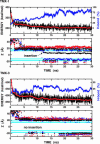Interfacial folding and membrane insertion of designed peptides studied by molecular dynamics simulations
- PMID: 15860587
- PMCID: PMC1100747
- DOI: 10.1073/pnas.0408135102
Interfacial folding and membrane insertion of designed peptides studied by molecular dynamics simulations
Abstract
The mechanism of interfacial folding and membrane insertion of designed peptides is explored by using an implicit membrane generalized Born model and replica-exchange molecular dynamics. Folding/insertion simulations initiated from fully extended peptide conformations in the aqueous phase, at least 28 A away from the membrane interface, demonstrate a general mechanism for structure formation and insertion (when it occurs). The predominately hydrophobic peptides from the synthetic WALP and TMX series first become localized at the membrane-solvent interface where they form significant helical secondary structure via a helix-turn-helix motif that inserts the central hydrophobic residues into the membrane interior, and then fluctuations occur that provide a persistent helical structure throughout the peptide and it inserts with its N-terminal end moving across the membrane. More specifically, we observed that: (i) the WALP peptides (WALP16, WALP19, and WALP23) spontaneously insert in the membrane as just noted; (ii) TMX-1 also inserts spontaneously after a similar mechanism and forms a transmembrane helix with a population of approximately 50% at 300 K; and (iii) TMX-3 does not insert, but exists in a fluctuating membrane interface-bound form. These findings are in excellent agreement with available experimental data and demonstrate the potential for new implicit solvent/membrane models together with advanced simulation protocols to guide experimental programs in exploring the nature and mechanism of membrane-associated folding and insertion of biologically important peptides.
Figures





Similar articles
-
Membrane adsorption, folding, insertion and translocation of synthetic trans-membrane peptides.Mol Membr Biol. 2008 Apr;25(3):245-57. doi: 10.1080/09687680802020313. Mol Membr Biol. 2008. PMID: 18428040
-
Folding is not required for bilayer insertion: replica exchange simulations of an alpha-helical peptide with an explicit lipid bilayer.Proteins. 2005 Jun 1;59(4):783-90. doi: 10.1002/prot.20460. Proteins. 2005. PMID: 15828005
-
Equilibrium structure and folding of a helix-forming peptide: circular dichroism measurements and replica-exchange molecular dynamics simulations.Biophys J. 2004 Dec;87(6):3786-98. doi: 10.1529/biophysj.104.045419. Epub 2004 Aug 31. Biophys J. 2004. PMID: 15339816 Free PMC article.
-
[A turning point in the knowledge of the structure-function-activity relations of elastin].J Soc Biol. 2001;195(2):181-93. J Soc Biol. 2001. PMID: 11727705 Review. French.
-
Peptide folding simulations.Curr Opin Struct Biol. 2003 Apr;13(2):168-74. doi: 10.1016/s0959-440x(03)00040-x. Curr Opin Struct Biol. 2003. PMID: 12727509 Review.
Cited by
-
Kinetics of peptide folding in lipid membranes.Biopolymers. 2015 Jul;104(4):281-90. doi: 10.1002/bip.22640. Biopolymers. 2015. PMID: 25808575 Free PMC article. Review.
-
Molecular dynamics simulations of model trans-membrane peptides in lipid bilayers: a systematic investigation of hydrophobic mismatch.Biophys J. 2006 Apr 1;90(7):2326-43. doi: 10.1529/biophysj.105.073395. Epub 2006 Jan 20. Biophys J. 2006. PMID: 16428278 Free PMC article.
-
Folding a viral peptide in different membrane environments: pathway and sampling analyses.J Biol Phys. 2018 Jun;44(2):195-209. doi: 10.1007/s10867-018-9490-y. Epub 2018 Apr 11. J Biol Phys. 2018. PMID: 29644513 Free PMC article.
-
Membrane-induced structural rearrangement and identification of a novel membrane anchor in talin F2F3.Biophys J. 2014 Nov 4;107(9):2059-69. doi: 10.1016/j.bpj.2014.09.022. Biophys J. 2014. PMID: 25418091 Free PMC article.
-
CHARMM: the biomolecular simulation program.J Comput Chem. 2009 Jul 30;30(10):1545-614. doi: 10.1002/jcc.21287. J Comput Chem. 2009. PMID: 19444816 Free PMC article. Review.
References
-
- White, S. H. & Wimley, W. C. (1999) Annu. Rev. Biophys. Biomol. 28, 319–365. - PubMed
-
- Popot, J. L. & Engelman, D. M. (2000) Annu. Rev. Biochem. 69, 881–922. - PubMed
-
- Chamberlain, A. K., Faham, S, Yohannan, S. & Bowie, J. U. (2003) Adv. Protein Chem. 63, 19–46. - PubMed
-
- Zasloff, M. (2002) Nature 415, 389–395. - PubMed
Publication types
MeSH terms
Substances
Grants and funding
LinkOut - more resources
Full Text Sources

